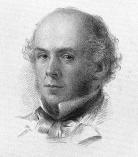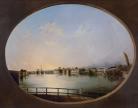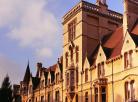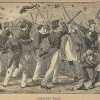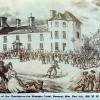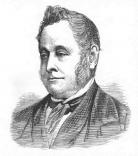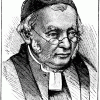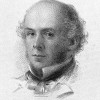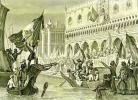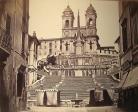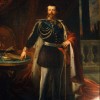Clough and Amours de Voyage Timeline
Created by Dino Franco Felluga on Wed, 12/23/2020 - 11:28
Part of Group:
 This timeline will include paratextual information about significant events that help to explicate Arthur Hugh Clough's Amour de Voyage. This omnibus edition has been prepared by the participants in a graduate seminar led by Dino Franco Felluga at Purdue University over winter 2021.
This timeline will include paratextual information about significant events that help to explicate Arthur Hugh Clough's Amour de Voyage. This omnibus edition has been prepared by the participants in a graduate seminar led by Dino Franco Felluga at Purdue University over winter 2021.
Timeline
Chronological table
| Date | Event | Created by | Associated Places | |
|---|---|---|---|---|
| 17 Mar 1805 |
Kingdom of Italy founded
This crowning of Napoleon as King of Italy is a result of the French conquest of Italy. Napoleon was crowned King of Italy with the iron crown of Lombardy on 26 May 1805 (crown pictured above). His full title was "Emperor of the French and King of Italy." ArticlesAlison Chapman, "On Il Risorgimento" Related ArticlesErik Simpson, "On Corinne, Or Italy" Marjorie Stone, “On the Post Office Espionage Scandal, 1844″ |
Dave Rettenmaier | ||
| 26 May 1805 |
Napoleon made king of Italy
In a flamboyant and highly theatrical gesture, Napoleon Bonaparte signifies his political and military dominance over the Italian peninsula with a ceremony in Milan Cathedral, where he crowned himself King of Italy with the ancient, iconic iron crown of Lombardy. This crowning of Napoleon as King is a result of the French conquest of Italy. His full title was "Emperor of the French and King of Italy." ArticlesAlison Chapman, "On Il Risorgimento" Related Articles |
Dave Rettenmaier | ||
| 1 Jan 1819 |
Birth of Arthur Hugh CloughThe poet, critic, and educator, Arthur Hugh Clough, was born on this date to James Butler Clough and Ann Perfect. Like his older siblings, Clough was born in Liverpool, England (Chorley 10). Works ReferencedChorley, Katharine. Arthur Hugh Clough: The Uncommitted Mind. Clarendon Press, 1962.
|
Matt Morgenstern | ||
| Dec 1822 to Jun 1828 |
Clough Family Relocates to Charleston, SCIn December 1822, the Clough family relocated from Liverpool to Charleston, South Carolina, and moved into a large house on East Bay Street (Kenny 1). Arthur Hugh Clough would live in the Charleston area until he returned to England in 1828 for his formal education, but while in the United States, Clough was educated at home by his mother, Ann Perfect, who did not want her children to see themselves as American. Nevertheless, Clough’s time in the United States seems to have had a lasting effect on his career as Antony Kenny notes in his biography of Clough, which discusses the ways the maritime imagery in Clough’s poetry is reminiscent of his childhood summers on Sullivan's Island (3). Image: View of Charleston (View from the East), 1846, by Henry Joseph Jackson. This image is part of the public domain and is available on Wikimedia Commons. Works ReferencedChorley, Katharine. Arthur Hugh Clough: The Uncommitted Mind. Clarendon Press, 1962. Kenny, Anthony. Arthur Hugh Clough: A Poet’s Life. Bloomsbury Academic, 2005. |
Emily Pearson | ||
| Mar 1829 to 1837 |
Arthur Hugh Clough at Rugby SchoolIn March 1829, Arthur Hugh Clough and his older brother, Charles, were enrolled in Rugby School, which was then under the control of Dr. Thomas Arnold (Chorley 9). During this time, Clough struggled with English schoolboy culture and was often separated from his parents for extending periods of time. Nevertheless, Clough came to thrive at Rugby, which was going through something of a cultural shift during his time there. Here, Clough began to write seriously for both school competitions and the school periodical (Kenny 14). Image: Football at Rugby School, unknown artist. This image is part of the public domain and is available on Wikimedia Commons. Works ReferencedChorley, Katharine. Arthur Hugh Clough: The Uncommitted Mind. Clarendon Press, 1962. Kenny, Anthony. Arthur Hugh Clough: A Poet’s Life. Bloomsbury Academic, 2005. |
Emily Pearson | ||
| 9 Sep 1833 to 25 Jan 1841 |
Tracts for the Times: 1833-1841Between 1833 and 1841, members of the Oxford Movement (including John Henry Newman, John Keble, Edward Pusey, Hurrell Froude, Benjamin Harrison, and others) published 90 pamphlets in defense of Anglo-Catholic doctrine. The Tracts for the Times were vital in disseminating and consolidating the principles of the Oxford Movement, or Tractarianism as it was henceforth known. Image: This image is in the public domain in the United States. ArticlesKimberly J. Stern, "The Publication of John Pentland Mahaffy's The Decay of Modern Preaching (1882)" Related ArticlesLaura Mooneyham White, "On Pusey's Oxford Sermon on the Eucharist, 24 May 1843" Miriam Burstein, "The 'Papal Aggression' Controversy, 1850-52" Barbara Charlesworth Gelpi, "14 July 1833: John Keble's Assize Sermon, National Apostasy" |
Dave Rettenmaier | ||
| 1837 |
Arthur Hugh Clough at Balliol CollegeArthur Hugh Clough left Rugby to start at Balliol College, which was considered among the most academically demanding colleges at the University of Oxford (Kenny 38). Oxford at this time was still a “religious and almost monastic institution,” and religion and religious tension would play a key role in Clough’s university career (32). Students at Oxford were required to subscribe to the Thirty-Nine Articles of the Church of England to matriculate, thus excluding Jewish peoples, atheists, Dissenters, and Catholics (32). Clough studied at Oxford during a tumultuous time for the university’s religious affiliations as the Tractarians and liberal Anglicans disagreed on the direction the church should move in. During this time, Clough’s friend and math tutor, W.G. Ward, a Tractarian, proved to be a tremendous influence on Clough’s thoughts about religion, philosophy, and art (Chorley 52). Although Clough was reportedly an excellent scholar, he performed poorly on the Oxford exams in 1841, earning Second-Class Honors rather than First-Class, to the surprise of many who knew him (Kenny 60). Clough seems to have taken the disappointment hard; he reportedly walked to Rugby, a distance of roughly 45 miles, after his exams to tell Dr. Arnold, “I have failed” (Armstrong 10). Image: The facade of Balliol College, Oxford. Photographed by Toby Ord, February 2005. Available on Wikimedia Commons. Works ReferencedArmstrong, Isobel. Arthur Hugh Clough. Longmans Green, 1962. Chorley, Katharine. Arthur Hugh Clough: The Uncommitted Mind. Clarendon Press, 1962. Kenny, Anthony. Arthur Hugh Clough: A Poet’s Life. Bloomsbury Academic, 2005. |
Emily Pearson | ||
| 14 Jun 1839 |
First Chartist Petition
ArticlesChris R. Vanden Bossche, "On Chartism" Related ArticlesJo Briggs, “1848 and 1851: A Reconsideration of the Historical Narrative” |
Dave Rettenmaier | ||
| Nov 1839 |
Newport Uprising
ArticlesChris R. Vanden Bossche, "On Chartism" Related ArticlesJo Briggs, “1848 and 1851: A Reconsideration of the Historical Narrative” |
Dave Rettenmaier | ||
| 2 May 1842 |
Second Chartist Petition
ArticlesChris R. Vanden Bossche, "On Chartism" Related ArticlesJo Briggs, “1848 and 1851: A Reconsideration of the Historical Narrative” |
Dave Rettenmaier | ||
| 8 Aug 1842 |
Manchester strike
ArticlesChris R. Vanden Bossche, "On Chartism" Related ArticlesJo Briggs, “1848 and 1851: A Reconsideration of the Historical Narrative” |
Dave Rettenmaier | ||
| Nov 1842 to 23 Jan 1848 |
Arthur Hugh Clough at Oriel CollegeAfter earning a Second for his Oxford exams and later taking an M.A., Arthur Hugh Clough earned a fellowship at Oriel College, Oxford. A tutor and teacher of many students, Clough was also close to figures on both sides of the Oxford Movement (including William George Ward, a Roman Catholic advocate for Tractarianism). Clough eventually resigned his position after refusing to teach the Thirty-Nine Articles, thereby dissenting from the Tractarianism that had become popular (Kenny 124). Image: Engraving of William George Ward, c. 1883. Public domain, available on Wikimedia. Works ReferencedChorley, Katharine. Arthur Hugh Clough: The Uncommitted Mind. Clarendon Press, 1962. Kenny, Anthony. Arthur Hugh Clough: A Poet’s Life. Bloomsbury Academic, 2005.
|
Matt Morgenstern | ||
| 24 May 1843 |
Pusey’s Oxford Sermon on the Eucharist
ArticlesLaura Mooneyham White, "On Pusey's Oxford Sermon on the Eucharist, 24 May 1843" Related ArticlesBarbara Charlesworth Gelpi, "14 July 1833: John Keble's Assize Sermon, National Apostasy" |
Dave Rettenmaier | ||
| 1848 |
Clough’s first meeting with Emerson
Related Articles |
Dave Rettenmaier | ||
| 1 Feb 1848 |
Tuscan uprising
To supporters of Italian independence, the short-lived uprising in Tuscany, leading to a new constitution as well as freedom of the press and of religious practice, seemed to be the first step to overthrowing foreign rulers ArticlesAlison Chapman, "On Il Risorgimento" ArticlesMarjorie Stone, “On the Post Office Espionage Scandal, 1844″ |
Dave Rettenmaier | ||
| 22 Mar 1848 to 22 Aug 1849 |
Republic of San MarcoVenetians rebelled against the Austrian Empire on 17 March 1848. The Republic of San Marco was founded on 22 March 1848 and Daniele Manin became its president. However, on 22 August 1849, the Austrian army overthrew the Republic of San Marco and re-established the supremacy of Austria in Venice. Immediately after the Austrians entered Venice on 27 August, President Daniele Manin and 39 revolutionary leaders fled Italy. Image: La proclamazione della Repubblica di San Marco, Marzo 1848, 1850, by Sanesi. This image is part of the public domain and is available on Wikimedia Commons. Additional ReadingCunsolo, Ronald. S. "Venice and the Revolution of 1848-49." in James Chastain et al. Encyclopedia of Revolutions of 1848, Ohio University, 27 Oct 2004, www.ohio.edu/chastain/rz/venrev.htm |
Gwenael Jouin | ||
| 23 Mar 1848 to 22 Aug 1849 |
First Italian War of Independence Albrecht Adam, Field Marshal Radetzky and His Staff at the Battle of Novara on March 23, 1849, 1855. The First Italian War of Independence pitted the Kingdom of Sardinia, defending the Republic of Rome, against the Austrian Empire, defending the monarchy. Historians divide the war into three phases. The first phase is from 23 March 1848 to 9 August 1848. After the Five Days of Milan (18-22 March 1848), King Charles-Albert of Sardinia declared war on Austria. With the help of the Papal States, the Grand Duchy of Tuscany, and the Kingdom of the Two Sicilies, King Charles-Albert defeated the Austrian Marshal Radetzky in Pastrego on 13 April, in Verona on 6 May, and in Peschiera on 30 May. However, during the Battle of Custoza (23-25 July 1848), the Austrian Army defeated the Sardinian army and king Charles-Albert capitulated on 5 August. The second phase is a truce from 9 August 1848 to 20 March 1849. The third phase is from 20 March 1849 to 24 March 1849. On 20 March 1849, King Charles-Albert declared war on Austria. The Austrian Army defeated the Sardinian army during the battle of Novara (22-23 March). The Armistice of Vignale, signed on 26 March, put an end to the war. Thus, Lombardy was once again ruled by Austria. It was also invaded by other conservative leaders. For example, Louis Napoleon Bonaparte sent ten thousand French soldiers to Civita Vecchia on 25 April 1849 to overthrow the Roman Republic. Image: Field Marshal Radetzky and His Staff at the Battle of Novara on March 23, 1849, 1855, by Albrecht Adam. This image is part of the public domain and is available on Wikimedia Commons. Additional ReadingsCoppa, Frank J. The Origins of the Italian Wars of Independence. Routledge, 1992. Smith, Denis Mack. Modern Italy: A Political History. University of Michigan Press, 1997. |
Gwenael Jouin | ||
| 10 Apr 1848 |
Chartist Rally, Kennington
Led by Feargus O’Connor, an estimated 25,000 Chartists meet on Kennington Common planning to march to Westminster to deliver a monster petition in favor of the six points of the People’s Charter. Police block bridges over the Thames containing the marchers south of the river, and the demonstration is broken up with some arrests and violence. However, the large scale revolt widely predicted and feared fails to materialize. ArticlesJo Briggs, “1848 and 1851: A Reconsideration of the Historical Narrative” |
Dave Rettenmaier | ||
| 1 Jul 1848 |
Trial of Chartist leaders
The summer of 1848 witnesses violence as Chartist leaders are arrested and secret plots against the government are infiltrated. By the end of August, after the arrest of several hundred Chartists and Irish Confederates, the movement for violent uprising in England is broken. ArticlesJo Briggs, “1848 and 1851: A Reconsideration of the Historical Narrative” |
Dave Rettenmaier | ||
| Nov 1848 |
Clough, The Bothie of Toper-Na-Fuosich
Related Articles |
Dave Rettenmaier | ||
| circa. Jan 1849 |
Clough, AmbarvaliaArthur Hugh Clough's Ambarvalia collection was published in January 1849. A follow-up to his previous narrative poem The Bothie of Toper-na-fuosich, Ambarvalia consisted of unpublished poems from Clough’s time at Oxford. It was met with some “charges of obscurity” (Chorley 180) by the periodical press. Ambarvalia was Clough's last poetry publication until Amours de Voyage in 1858. Image: Scan of first edition cover of Ambarvalia from Chapman and Hall publisher. Public domain; available on Wikisource. Works ReferencedChorley, Katharine. Arthur Hugh Clough: The Uncommitted Mind. Clarendon Press, 1962. |
Matt Morgenstern | ||
| 9 Feb 1849 to Jul 1849 |
Roman Republic
ArticlesAlison Chapman, "On Il Risorgimento" Related ArticlesMarjorie Stone, “On the Post Office Espionage Scandal, 1844″ |
Dave Rettenmaier | ||
| The middle of the month Apr 1849 to 17 Jul 1849 |
Arthur Hugh Clough in RomeIn April 1849, Arthur Hugh Clough traveled to Rome to witness the struggle for Italian independence from both Vatican and Austrian authorities. While in Rome, Clough lived with a Swiss family located at 74 Via delle Croce near the Piazza di Spagna (Kenny 157). Clough left Rome in July to see the rest of the country. Though his stay in Rome was brief, Clough's experiences there were instrumental to the narrative of his verse-novel, Amours de Voyage. Image: "Trinità dei Monti" (with The Spanish Steps). Photograph by Robert MacPherson, c. 1860. Public domain. Works ReferencedKenny, Anthony. Arthur Hugh Clough: A Poet’s Life. Bloomsbury Academic, 2005. |
Matt Morgenstern | ||
| 25 Apr 1849 to 3 Jul 1849 |
French Troops Land at Civita Vecchia.On 25 April 1849, ten thousand French soldiers led by General Charles Oudinot landed at Civita Vecchia to fight Roman revolutionaries. On 3 July 1849, the power of pope Pius IX was restored in Rome. Image: Assalto delle truppe francesci a Roma nel 1849, 1860, by Melchiorre Fontana. This image is part of the public domain and is available on Wikimedia Commons. Additional ReadingBanti, Alberto Mario. Il Risorgimento italiano. Editori Laterza, 2013. |
Gwenael Jouin | ||
| 30 Oct 1852 |
Arthur Hugh Clough travels to US
Articles |
Dave Rettenmaier | ||
| 13 Jun 1854 |
Arthur Hugh Clough marries Blanche SmithClough married Blanche Smith on 13 June 1853 after a prolonged, long-distance engagement (Chorley 295). During the early years of the marriage, Clough and Blanche lived primarily in London, although they traveled extensively—sometimes together and sometimes apart—in the last year of Clough’s life when his health was failing. The couple had 4 children together, although one son died in early infancy (Chorley 310). Their youngest child, Blanche Athena, later became a principal of Newnham College, Cambridge, following in the footsteps of her paternal aunt. Through Blanche, Clough met Florence Nightingale, with whom he worked on a lengthy report on medical practices in the British military (Kenny 268-9). Image: Engraving of Arthur Hugh Clough. This work is in the public domain in its country of origin and other countries and areas where the copyright term is the author's life plus 70 years or less. Works ReferencedChorley, Katharine. Arthur Hugh Clough: The Uncommitted Mind. Clarendon Press, 1962. Kenny, Anthony. Arthur Hugh Clough: A Poet’s Life. Bloomsbury Academic, 2005. |
Emily Pearson | ||
| 1 Feb 1861 |
Italy is united
ArticlesAlison Chapman, "On Il Risorgimento" Related ArticlesMarjorie Stone, “On the Post Office Espionage Scandal, 1844″ |
Dave Rettenmaier | ||
| 1 Nov 1861 |
death of Arthur Hugh Clough
Related Articles |
Dave Rettenmaier | ||
| 2 Oct 1870 |
Rome annexed to ItalyPlebiscite annexes Rome and Latium to the Kingdom of Italy, 2 October 1870. This event marks the final phase of the unification of Italy. ArticlesAlison Chapman, "On Il Risorgimento" Related ArticlesMarjorie Stone, “On the Post Office Espionage Scandal, 1844″ |
Dave Rettenmaier |


